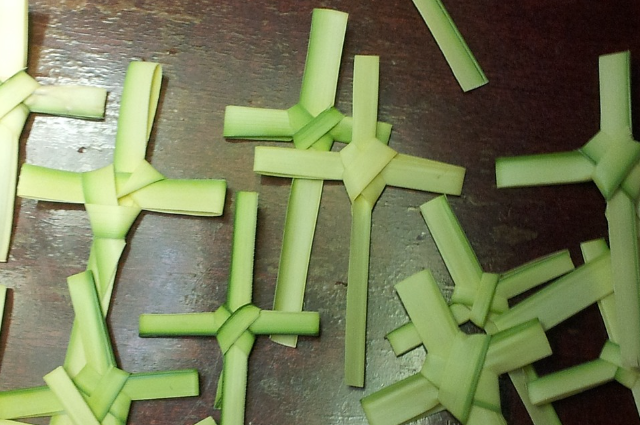
Image by CKSherrod from Pixabay
Holy Week is a sacred period observed by Christians around the world, commemorating the final week of Jesus Christ’s earthly life. This week holds immense significance in Christianity, marking key events that lead to the resurrection and salvation. The observance of Holy Week typically begins with Palm Sunday and concludes with Easter Sunday, encapsulating the profound journey of faith, reflection, and redemption.
Palm Sunday: Triumphal Entry
The week commences with Palm Sunday, recalling Jesus’ triumphant entry into Jerusalem. Crowds welcomed Him with palm branches, symbolizing victory and peace. This event sets the stage for the unfolding drama of Holy Week, emphasizing the anticipation of the Messiah’s arrival.
Maundy Thursday: Last Supper and Washing of Feet
Maundy Thursday commemorates the Last Supper, where Jesus shared the Passover meal with His disciples. During this sacred gathering, He instituted the Holy Communion, symbolizing His body and blood. The humility displayed by Jesus as He washed His disciples' feet underscores the essence of servant leadership.
Good Friday: Crucifixion and Sacrifice
Good Friday is a solemn day that commemorates the crucifixion of Jesus Christ. It is a day of reflection on the profound sacrifice made for humanity’s sins. The Stations of the Cross are often retraced, highlighting the agony, suffering, and ultimate sacrifice of Jesus on the cross. Believers engage in prayer and meditation, contemplating the depth of God’s love expressed through this sacrifice.
Holy Saturday: Vigil and Waiting
Holy Saturday is a day of vigil and waiting, symbolizing the time Jesus spent in the tomb. Churches hold Easter Vigils, marking the transition from darkness to light, symbolizing the resurrection. This period invites believers to contemplate the significance of Christ’s death and await the joyous proclamation of His resurrection.
Easter Sunday: Resurrection and Celebration
Easter Sunday marks the pinnacle of Holy Week, celebrating the resurrection of Jesus Christ. Churches are adorned with lilies and joyful hymns resonate, symbolizing the triumph of life over death. The Resurrection narrative brings hope, reaffirming the core Christian belief in eternal life and redemption.
Reflection and Spiritual Renewal
Throughout Holy Week, believers engage in spiritual practices such as prayer, fasting, and reflection. The journey from the exuberance of Palm Sunday to the solemnity of Good Friday and the anticipation of Easter Sunday invites individuals to introspect on their faith, values, and commitment to following Christ’s teachings.
Global Traditions and Variations
Holy Week is observed globally with diverse cultural and religious expressions. Processions, reenactments, and religious services vary, showcasing the rich tapestry of Christian traditions. From the somber processions in Spain to the joyful celebrations in the Philippines, each culture adds unique elements to the shared narrative of Holy Week.
Symbols and Rituals: Deeper Meaning
Holy Week is rich with symbols and rituals that carry profound meanings. The palm branches on Palm Sunday signify triumph and peace, while the bread and wine during the Last Supper embody the essence of communion and unity. The cross, a central symbol of Christianity, becomes particularly poignant on Good Friday, representing sacrifice and salvation. These symbols serve as tangible reminders of the spiritual journey undertaken during this sacred week.
Communal Worship and Reflection
Communal worship plays a central role during Holy Week. The collective observance of rituals and liturgies fosters a sense of community among believers. It is a time when Christians come together to share in the collective narrative of salvation, finding strength and solace in their shared faith. The somber tones of Good Friday gradually give way to the jubilant celebrations of Easter Sunday, mirroring the ebb and flow of life’s challenges and triumphs.
Holy Week in Art and Literature
Art and literature have captured the essence of Holy Week throughout history. From iconic paintings depicting the Passion of Christ to literary masterpieces exploring the depth of human and divine emotions, Holy Week has been a wellspring of inspiration. These creative expressions serve as a bridge between the sacred and the secular, allowing individuals to connect with the profound themes of faith and redemption on a deeply emotional level.
Modern Observance and Contemporary Challenges
In the contemporary context, Holy Week is observed against the backdrop of modern challenges. The themes of sacrifice, redemption, and hope resonate amidst the complexities of the modern world. Believers grapple with questions of social justice, compassion, and inclusivity, seeking to apply the timeless teachings of Holy Week to the pressing issues of our time.
Beyond Denominational Boundaries
While Holy Week is particularly significant for Christians, its themes of sacrifice, renewal, and hope are universal. People from various religious and cultural backgrounds can find inspiration in the messages of compassion, forgiveness, and resurrection. The inclusivity of these themes extends an Invitation for reflection and spiritual growth to a broader audience, fostering a sense of shared humanity.
Conclusion
Holy Week encapsulates the core tenets of Christianity – faith, sacrifice, redemption, and resurrection. It provides believers with an opportunity for deep spiritual introspection and serves as a reminder of the transformative power of divine love. As Christians worldwide partake in the rituals and observances, Holy Week remains a sacred pilgrimage, guiding them through the profound and eternal truths of their faith.
